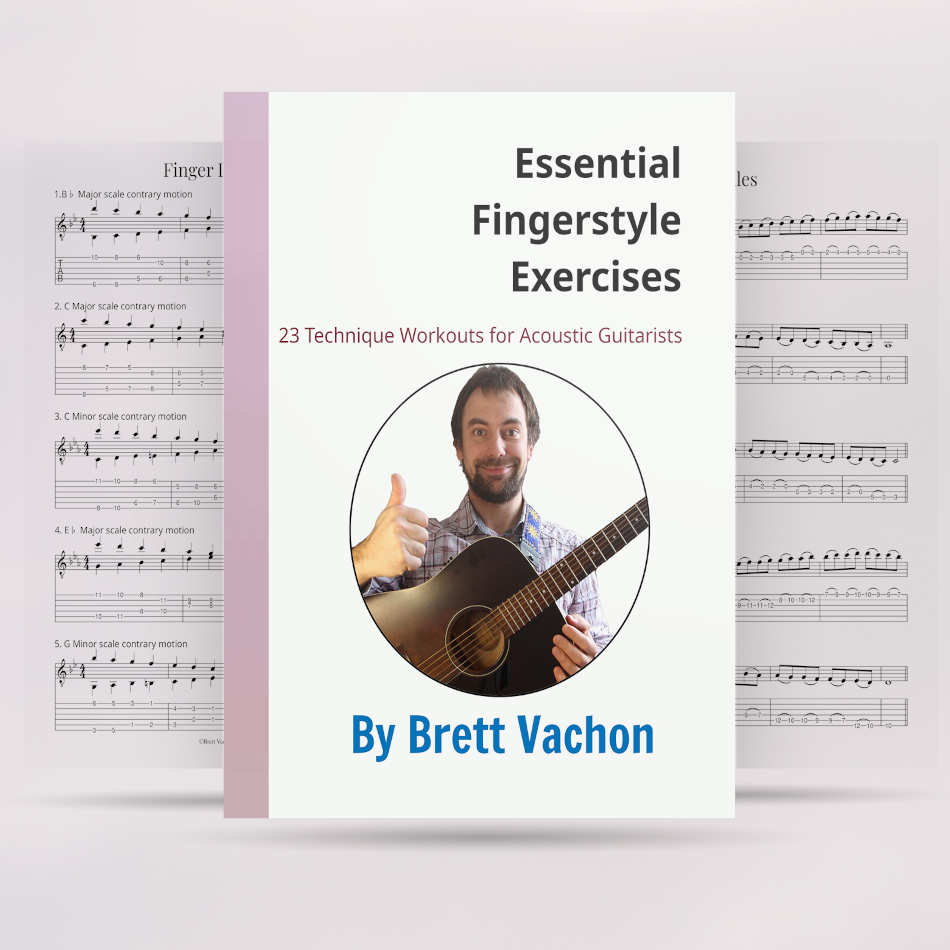Get started here with this complete introductory guide to fingerstyle guitar.
Did you know that there's a way that even relative beginner guitarists can produce beautiful sounding music?
By playing fingerstyle guitar, you can combine melodies with some simple bass lines and play arrangements relatively quickly.
Other ways of playing guitar, such as with pick can be a little limiting if you don't want to strum chords.
And techniques such as fast soloing or sweep picking take a lot of practice to get right!
But with the techniques that you will read about here, you can get started playing fingerstyle arrangements relatively quickly and enhance your musical individuality.
What Is Fingerstyle Guitar?
Fingerstyle guitar as the name suggests, involves plucking the guitar with the fingers of the hand, instead of setting the strings in motion using a pick. This is also called "fingerpicking".
The art of playing guitar fingerstyle goes back to the Renaissance era, to when the vihuela, a precursor to the guitar, was popular.
This instrument was sometimes referred to as the vihuela de mano in order to distinguish it from the other ways of playing the vihuela, like striking the strings with a pick or drawing across the strings with a bow.
Originally, the guitar was used only for strumming to accompany songs, as it is still used today. But with the invention of the baroque guitar with five courses, guitarists began to play more complex lines by plucking the strings with their fingers.
Fingerstyle guitar was born.
What Guitar Can I Use To Play Fingerstyle?
Although fingerstyle guitar is now commonly played on a metal string guitar, you can choose to start playing on a classical guitar. It's really a matter of choice and sound quality.
Originally, the guitar was much smaller and strung with gut strings, a disgusting product created from sheep's intestines.
Later, with the invention of the arch top guitar by Gibson, manufacturers could string their guitars using stronger materials such as steel.
When choosing a guitar, consider your budget and skill level. You may not need a high-end guitar, but don't hesitate to choose a more expensive instrument. You will be better off, as poor quality or cheaply made instruments will make learning difficult.
Should You Grow Nails to Play Fingerstyle Guitar?
My personal preference is to have at least some fingernail, although artificial nails are a good substitute.
Because the ring finger is shorter, I recommend growing your nail on your ring finger slightly longer than the other fingernails of your plucking hand.
If your nails are prone to breakage, be sure to have a substitute available, or consider strengthening your nails with acrylic..
How Can I Become Good At Fingerstyle Guitar Playing?
Learning fingerstyle guitar requires dedicated practice and consistent effort to develop the necessary muscle memory and coordination in the right hand. However, with patience and perseverance, anyone can learn how to play fingerstyle guitar.
It's common to experience frustration and plateaus when learning fingerstyle guitar. However, there are strategies that can help you overcome these challenges.
For example, you could focus on playing a specific fingerpicking pattern for five minutes at a time. This can help you make progress without feeling overwhelmed.
Also, don't start off with learning challenging fingerstyle songs right off the bat. Start with some easier fingerstyle songs, such as the ones in my online course Play Fingerstyle Guitar Now!
Should I Learn To Play Fingerstyle Guitar?
Learning fingerstyle guitar can be a fun and rewarding experience. Use a guitar method that lays out step by step what to learn, such as Play Fingerstyle Guitar Now!
Thus, you can quickly develop the skills you need to play this versatile and expressive style of guitar. In fact, with consistent practice and the right resources, anyone can learn how to play fingerstyle guitar.
While it might seem like a daunting technique to learn, it is definitely worth the effort.
Not only does fingerstyle guitar allow you to play complex melodies and harmonies, but it also gives you greater control over the tone and dynamics of your playing.
You can start learning fingerstyle guitar straight away, after learning to play some basic chords. I recommend starting with the online course Play Fingerstyle Guitar Now!



